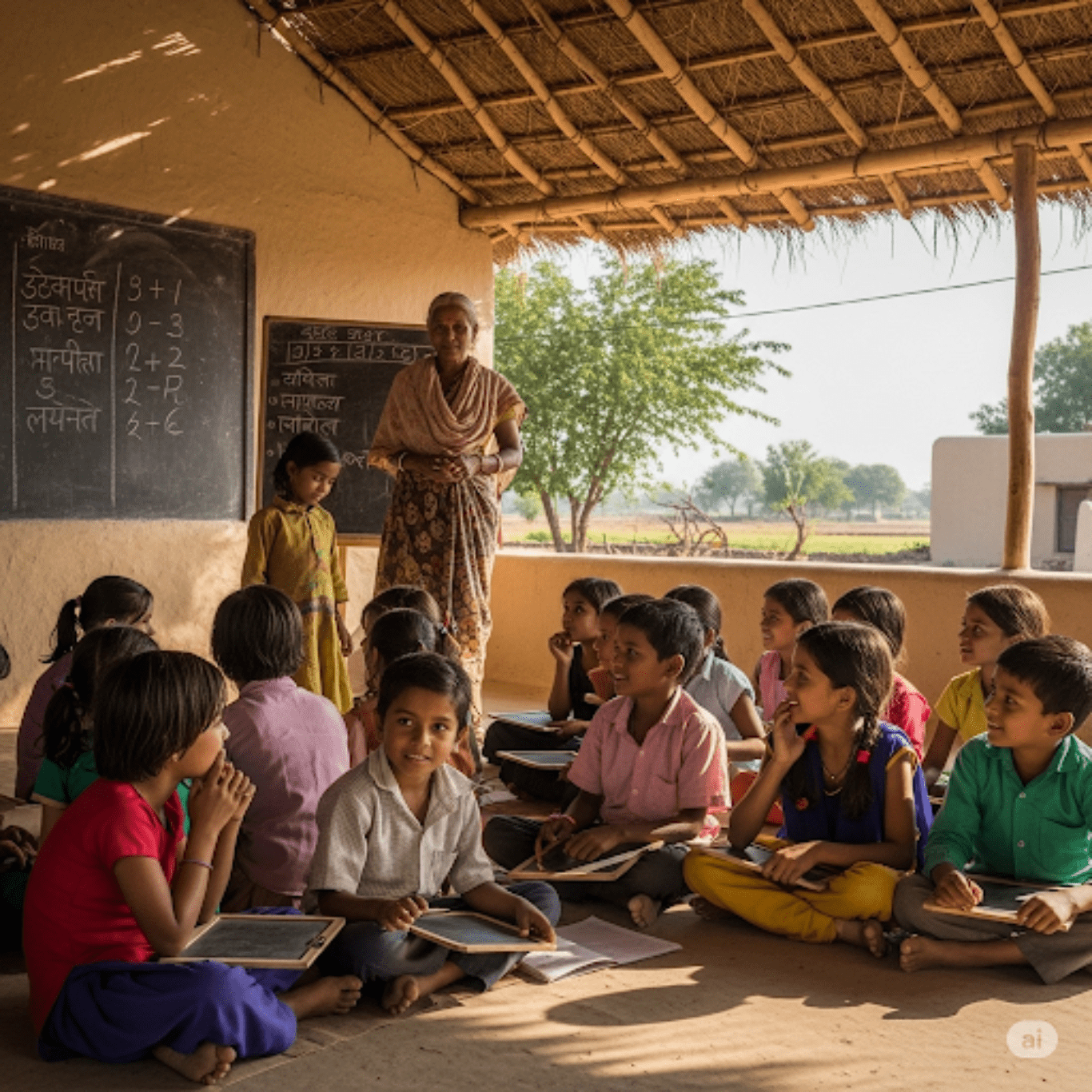Despite significant government and NGO efforts over the years, rural education in India continues to face substantial challenges that prevent millions of children from accessing quality education. the progress made by the government and non-governmental organizations over the years. These educational barriers, from infrastructure gaps to poor access to digital technology, prevent millions of kids from receiving the education they deserve.
Here’s the truth: you don’t have to be a politician to make a change. Even individuals and small groups, with the right awareness and actions, can help bridge the rural-urban educational divide.
Rural Schools Lacking Adequate Infrastructure
Government data shows that 23% of rural schools lack basic drinking water facilities, and 15% don’t have functional toilets. The lack of toilets and clean drinking water in schools, as well as electricity, is one of India’s primary educational barriers. Lack of sanitation facilities is a major reason for girls dropping out. Students are often seated in crumbling classrooms with poor ventilation and lighting.
In order to solve the educational issues faced by remote village schools, it is important to address these infrastructure gaps. Supporting local school improvements or community-led initiatives can boost school attendance and improve learning outcomes.
Closely related to infrastructure challenges is the issue of insufficient and inconsistent human resources in rural schools.
2. Teacher Absenteeism and Shortages
According to the Ministry of Education’s UDISE+ data, India faces over 1.2 million teacher vacancies, with rural areas bearing the brunt of this shortage. Rural teachers are often posted far away from their hometowns and are not motivated or do not have adequate supervision.
The lack of support and training for teachers in the local area is one of the main educational barriers. You can help bridge this gap as an educator, skilled volunteer, or by supporting platforms that focus on village education reform like Vidyalaya.org, which is dedicated to improving rural education by data-driven interventions.
While physical barriers are significant, human resource challenges pose equal concern, particularly in communication and teaching methods.
3. Language Barriers to Education
India’s linguistic variety adds to the complexity of its education system. Children in many villages grow up speaking tribal or regional dialects, but school instruction is usually given in Hindi or English. This language barrier leads to confusion, poor comprehension, and eventually student dropouts
To overcome these educational barriers, you need bilingual and contextualized learning materials. By promoting or creating regional language resources, more rural Indian students can access education.
4. Long Distances to Schools
Many children in remote villages must travel several kilometers to reach the nearest school. They often have to walk long distances over rough terrain, as there is no public transportation. This journey is especially challenging for young girls and younger children, who are often forced to drop out of school due to fatigue.
Supporting bicycle donation drives or setting up local transport systems via panchayats and NGOs helps with these access-to-school issues in remote communities.
Beyond staffing issues, socioeconomic factors create additional hurdles that keep children out of school.
5. Child Labour and Economic Pressures
In rural India, poverty is one of the biggest barriers to education. Many families rely on their children to earn extra income by doing farm work, household chores, or labor.
For these families, immediate survival takes precedence over education. Supporting midday meal programs, scholarship programs, or conditional cash transfers, you can help reduce dropouts and encourage children to focus on their education rather than survival.
6. Digital Literacy and Technology Access
The digital divide has widened significantly as online education becomes more prevalent. Rural schools are not equipped with internet, devices, or power. This growing digital divide is now a major educational barriers in rural areas.
Individuals can help by donating refurbished devices, setting up low-cost classrooms, or supporting initiatives like Vidyalaya.org, which bring tech-enabled solutions to rural schools that are underserved.
7. Gender Disparity and Social Norms
In rural India, girls are still discriminated against when it comes time to get an education. Girls are often forced to leave school early or never enroll due to a variety of reasons, including safety concerns and cultural attitudes that favor boys.
To break this cycle, we need targeted interventions such as mentorship programs for young girls, family counseling, or awareness campaigns at the community level. To achieve holistic rural development, it is important to tackle gender-based education barriers.
8. Nutritional deficiencies and poor health
Children who are undernourished or unwell find it difficult to concentrate, be active, or attend regularly. Poor health leads to frequent absenteeism, disrupting children’s learning continuity
Health-related barriers to education can be removed by running health check-ups and providing hygiene kits and nutrition support.
9. Low Parental Literacy and Engagement
Many rural families have parents who are either illiterate or not educated. It is difficult for parents to provide support to their children’s education, and the value of formal schooling is reduced.
You can support community workshops explaining the long-term advantages of education, parent engagement campaigns, or WhatsApp-based awareness content. Addressing this barrier often leads to improved student motivation and retention
10. Rote learning over conceptual understanding
Most rural schools still use outdated teaching methods that focus on memorization. This limits children’s critical thinking and leaves them ill-prepared for real-life challenges.
Promote activity-based kits, digital storytelling, or concept-based education to modernize rural classrooms. This will help overcome one of India’s most pressing challenges
How You Can Make a Difference
Help is available to anyone, regardless of their financial status or political affiliation. Start small but be consistent.
Adopting a school is possible through NGOs that are verified. You can help with the infrastructure and academic needs.
Online or on the ground, you can volunteer your time and skills.
Improve digital access to education or teaching methods by partnering with local educators.
Talk, share, and post to raise awareness of the education barriers still present in India’s rural villages.
Final Thoughts: Change Begins with You
India can only grow when its villages grow, and education is the strongest pillar of that growth. Rural education challenges in India are complex but not insurmountable. We all have a part to play, whether we are teachers, donors, advocates, or volunteers.
You’re not only helping a single student when you invest in their education. You’re also uplifting an entire generation.
FAQs on Educational Barriers in India
Q. What are the main educational barriers in rural India?
In rural India, the main barriers to education include teacher shortages and language barriers, as well as economic pressures and poor digital access. Each of these factors affects student retention and learning outcomes.
Q. How severe are rural education challenges India-wide?
The rural education challenges in India affect millions. The persistent issues of absenteeism and poverty in India, as well as outdated teaching methods, are a result of targeted interventions.
Q. How can communities support rural schools?
Communities can support rural schools locally by donating materials (books, laptops), stepping up to tutor, advocating for improved infrastructure, and running campaigns on rural education challenges in India.
Q. How is the government tackling rural education challenges in India?
In order to address challenges in rural education in India, the government has launched digital classrooms, mid-day meals, and Samagra Shiksha. These steps are encouraging, but there are still many educational obstacles that need to be addressed.

